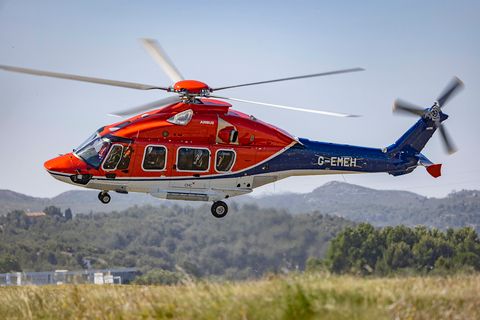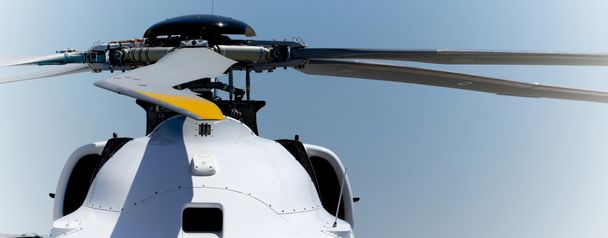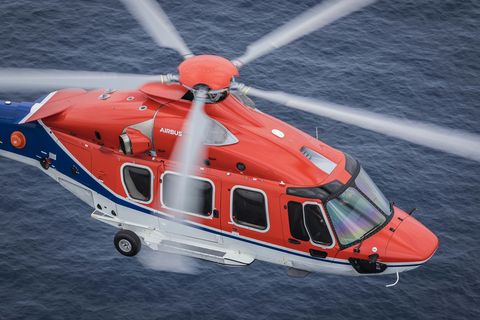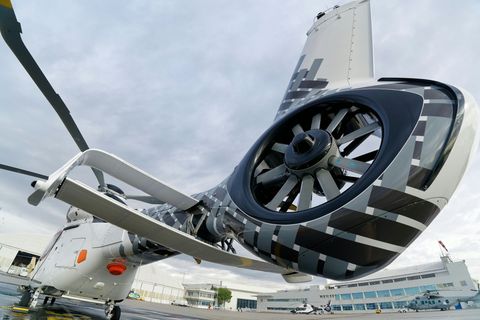In service since 2015, Airbus’ H175 belongs to the super-medium class of helicopters – combining long range with smooth flight qualities. It takes customers to the next level in terms of comfort, efficiency, and cost-effectiveness.
The H175 addresses several missions, including:
- Offshore crew change
- Law enforcement
- Search and rescue (SAR)
- Helicopter emergency medical services (HEMS)
- Private and business aviation
- Government VVIP
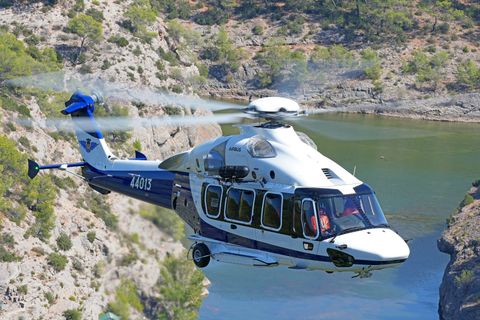
A world record-setter
The H175 is a record-setting helicopter, establishing a time-to-climb record of 6,000 metres in 6 min., 54 sec., as well as a time-to-climb record of 3,000 metres in 3 min., 10 sec.

1 - 2 pilots

155 kts

Over 6h

600 NM
Fast, smooth and comfortable
Airbus’ H175 combines high speed (above 155 kts) with smooth flight qualities, excellent payload and cabin comfort.
The H175’s extended, air-conditioned cabin provides the most volume and window surface per passenger in its class. A maximum of four passengers can be seated per row. Vibration and sound levels are low, even at high cruise speeds, contributing to a smooth flight.

Performing beyond expectations
Contributing to the H175’s competitive edge is its capacity to perform long-range missions at a fast cruise speed of 155 kts while maintaining a large payload. With a standard fuel tank capacity of over 2 tonnes, the H175 offers flexibility to operators for range and endurance. The H175 also excels in hot climates with an extensive power reserve and heli-deck performance (PC1) at maximum takeoff weight in ISA+20°C conditions.
Powered by two PT6C 67E versions of Pratt & Whitney Canada’s highly reliable turboshaft PT6 engines, the H175 benefits from excellent performance – even in one engine inoperative (OEI) scenarios – and large power reserves, which support efficiency and safety during takeoff and landing, rig approach, hovering and hoisting.

The pilot’s first choice
The H175's Helionix® avionics suite and integrated 4-axis autopilot – improved from Airbus’ H225 helicopter – provide the highest levels of safety and mission flexibility.
Meeting the latest international standards, Helionix® reduces pilot workload through unrivalled situational awareness, improved flight envelope protection and system redundancy.
The dual-duplex 4-axis automatic flight control system (AFCS) ensures precision and stability during flight, and reliability even in the harshest weather conditions. Its functions include new automatic modes such as automatic recovery in the event of pilot disorientation, easier final approaches (particularly at low heights, providing prevention against terrain collision), a hands-off one-engine failure management mode, and a Rig N’ Fly mode for approaches to gas/oil rigs. The TCAS II function for automatic collision avoidance also supports the helicopter’s overall flight safety.
An intuitive human-machine interface further reduces pilot workload and has an innovative self-monitoring and alerting system, backed by audio warnings.
Cockpit commonality offers multi-platform customers with training credits. The Airbus-designed Helionix avionics system also is incorporated on the company’ bs H135 and H145 helicopters, as well as the H160.

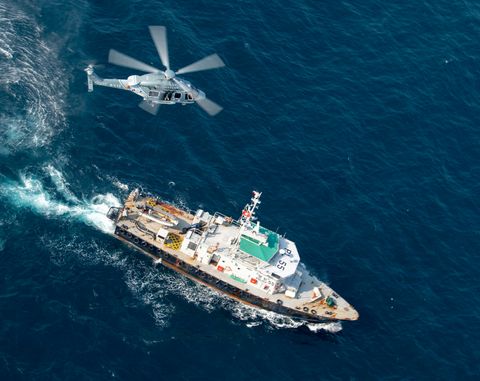
Saving lives at the centre of a typhoon
Hong Kong GFS and their H175 fleet have no fear
In the early hours on a July morning, the floating crane vessel "Fujing 001" was sheltering from Typhoon "Siampa" at an anchorage near Yangjiang, Guangdong Province, China, when its anchor chain broke and it was in distress. Hong Kong GFS with their fleet of H175s came to the rescue.

Designed with safety in mind
The H175 was conceived from the start to offer the highest safety levels in all flight modes. The helicopter complies with – or exceeds – the latest CS29 airworthiness standards, with the oil and gas version incorporating all of the safety and mission recommendations of the IOGP (International Association of Energy Producers).
To achieve these standards, the helicopter has fully redundant systems; crashworthiness protection; energy- absorbing landing gear, seats, structure and fuel tanks; and emergency floatation devices, which can be inflated in flight manually or automatically at ditching.
The emergency floatation system is certified at Sea State 6 conditions, with the high water-line reducing the risk of capsizing.
The H175 includes:
● 4-axis autopilot;
● Rig’N Fly automatic approach mode for oil/gas platforms;
● Localiser performance with vertical guidance (LPV);
● Synthetic vision system (SVS);
● Health and usage monitoring system (HUMS);
● Helicopter flight data monitoring (HFDM);
● Alerting and failure management system;
● Helicopter terrain awareness and warning system (HTAWS);
● Traffic collision avoidance system (TCAS II);
● Automated dependent surveillance-broadcast (ADS-B Out);
● Unrivalled pilot assistance with the Helionix® avionics suite, with features such as vortex ring prevention, recovery in case of loss of external reference, etc.
For passenger safety, quick and easy egress is provided through extra-large push-out windows that exceed EASA Type IV emergency egress size requirements, while each passenger is seated at a maximum of one seat from an egress exit.
On-ground safety is provided by the rotorcraft’s high-set tail rotor with a 2.3-metre ground clearance to facilitate movement around the aircraft – especially during operations on landing pads. Passenger boarding is enhanced by the real-time view provided by a tail-fin-mounted forward-looking camera, which is monitored from the cockpit display.
An autonomous cockpit camera can record cockpit crew actions and replay missions for training and procedural improvement purposes.
H175 in focus
Discover more
Related news


